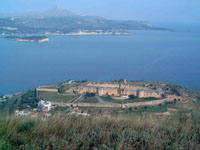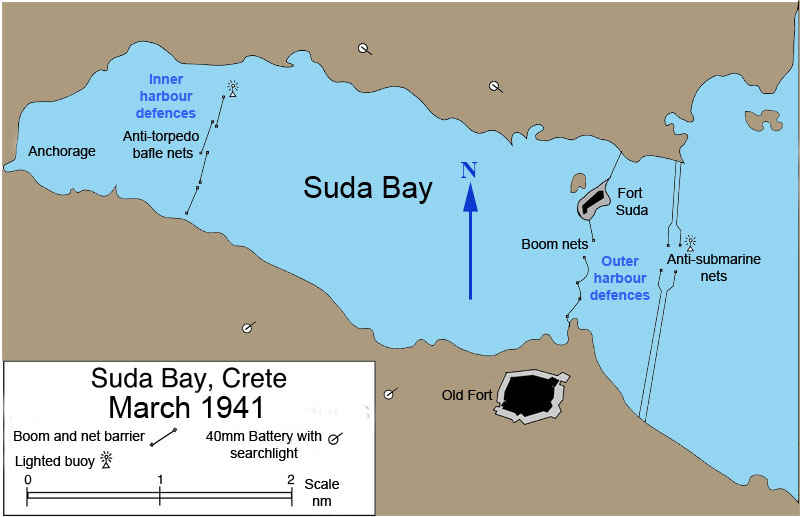Suda Bay, Greece
 |
 |
 |
| Suda Bay - Old Moorish Fort | Suda Bay - Inner Harbour | Suda War Cemetary |
The Royal Navy installed a number of harbour defences at Suda Bay (Souda Bay) Crete, Greece, at the outset of World War 2. These consisted of three sets of nets. The outer net defences consisted of two sets of nets running either side of Suda Island to the shore on either side. A gate in the middle could be opened by a boat. About three miles west of these lines was the inner defence - an anti-torpedo baffle net protecting the inner anchorage at the head of the bay. Indicator loops were planned for Suda Bay in November 1940.
Photos and research by Dr. Richard Walding (copyright).
 |
If you worked there or have any feedback please email me: Dr Richard Walding Research Fellow - School of Science Griffith University Brisbane, Australia Email: waldingr49@gmail.com |
LINKS TO RELATED PAGES:
SUDA BAY LOOPS
On the 4th November 1940, the British Admiralty gave permission to install anti-submarine indicator loops at the entrance to Suda Bay. However, the Germans captured Suda Bay in May 1941 before the loops could be installed. At the time of the daring Italian raid on the Bay in late March 1941, the arrangement of harbour defences was as shown below:

On 25thOctober 1940, Italy invaded Greece. This enabled Great Britain to make use of the Island of Crete as a much needed advanced base in the Eastern Mediterranean for sea and air operations against the Italians. The strategic importance of this Island had been fully appreciated, and the decision had been taken from the first to hold it whatever might happen on the mainland of Greece, though it was realised that in the event of Greece being overrun by the Germans, the use of Crete would be limited by the scale of air attack which might be brought to bear on it from Greek airfields. The day after the Italian invasion commenced, the Commander-in-Chief, Middle East1, was authorised to send up to a Brigade to Crete, and in addition artillery and A.A. guns. No time was lost in the Middle East, and two days later, (31st October) a convoy from Alexandria with a base defence party from H.M.S. Liverpool, coast defence guns, such underwater defence nets as were available and miscellaneous stores arrived at Suda Bay. By the 7th November, a battalion of the York and Lancaster Regiment, Bofors guns and crews, and 10,000 tons of military stores, including 3'7-inch H.A. guns, had been landed; a battalion of the Black Watch and a battalion of the Leicesters subsequently arrived, with certain other details, bringing the strength of the garrison up to 7,ooo2. By the end of the month, shore defences and a limited number of A.A. posts had been erected.3 Between November and April periodical air raids were carried out by the enemy on the Suda Bay and Heraklion areas, but they were not particularly heavy and little was achieved by them. Until the German attack on Greece in April 1941, the port of Suda was used as a fuelling base by cruisers and destroyers.4 For the latter it was of the greatest importance, enabling them to operate for long periods in the central Mediterranean. Later it filled the important functions of a supply base for the Army in Crete, until the evacuation of the Island at the end of May.
If you have any further details of Suda Bay harbour defences or antisubmarine harbour defences in general (Indicator Loops and Harbour Defence Asdic) that may help with this research project please email me at the address at the top of the page.